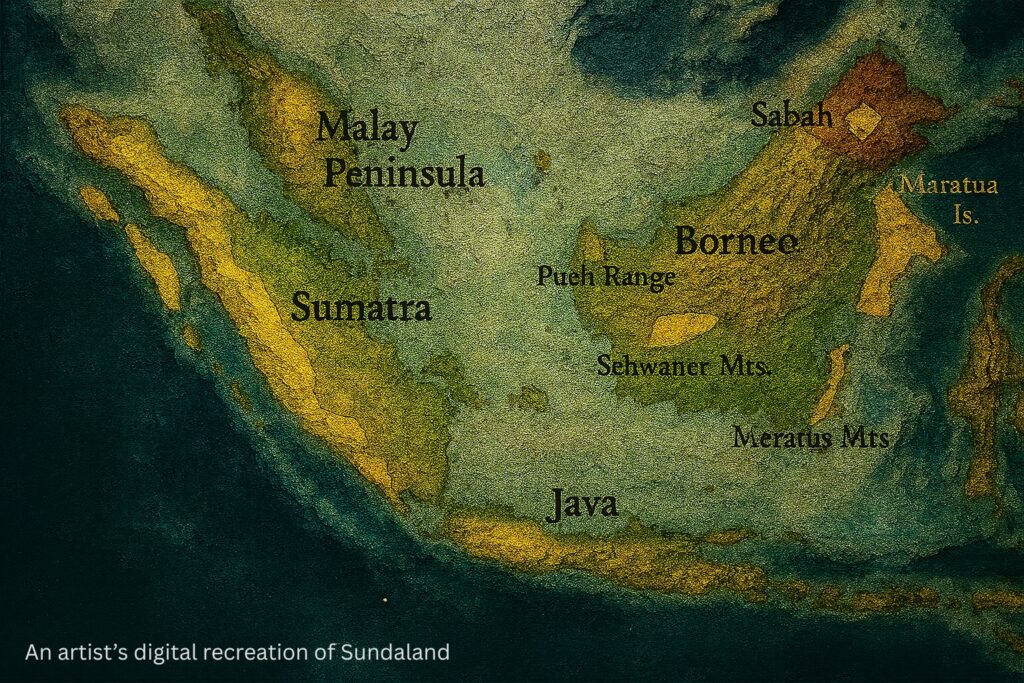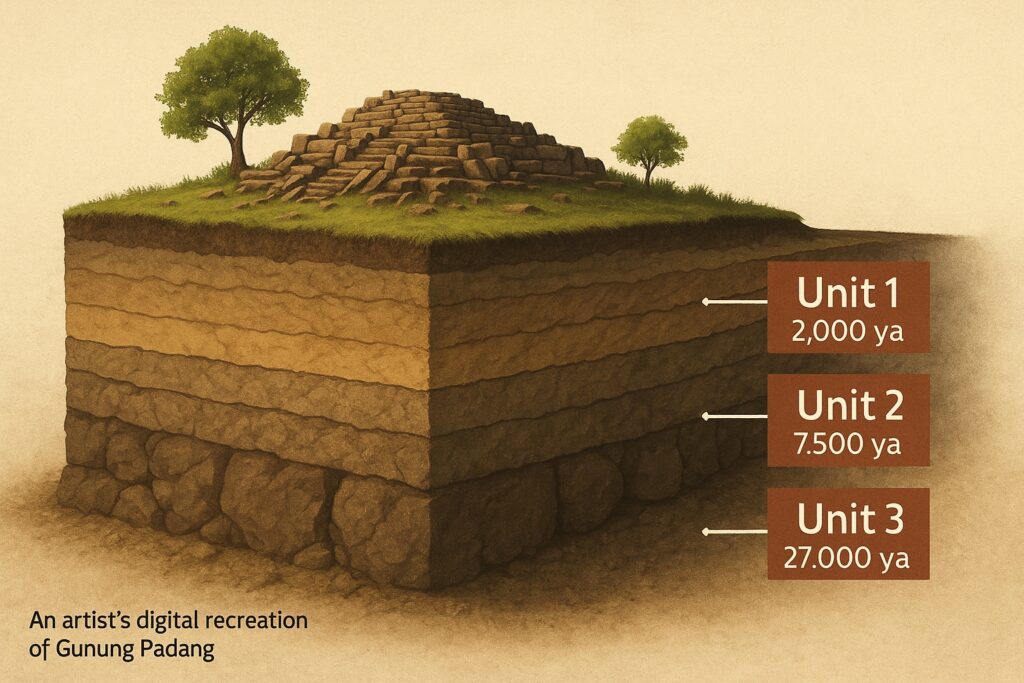Have you ever stood on a hill and felt a strange sense of history beneath your feet? A feeling that you are a latecomer to a story that began long, long ago? In the West Java province of Indonesia, there is such a place. It’s a terraced, stone-topped hill known as Gunung Padang, the “Mountain of Light.” For generations, locals have revered it as a sacred site, a place of ancestral power.
“But what if it’s not a hill at all? What if it’s a monument, an artificial pyramid so ancient it could shatter our entire understanding of the human story?”
This is the question that hangs in the humid air around Gunung Padang, a question that has ignited one of the most ferocious debates in modern archaeology. It challenges us to look at a simple hill of volcanic rock and see the blueprint of a lost civilization, one that may have thrived not in our warm, stable world, but deep within the last Ice Age.
What is Sundaland and How Does It Relate to Gunung Padang?
A Mountain of Light on a Land Lost to the Sea
Before we touch the stones, we must understand the ground on which they rest. The story of Gunung Padang cannot be separated from the story of Sundaland. During the last glacial maximum, when vast ice sheets locked up the world’s water, the sea level was dramatically lower. The islands we know today as Sumatra, Java, and Borneo were not islands at all, but part of a single, massive peninsula connected to mainland Asia. This was Sundaland—a vast, tropical plain teeming with life.
Then, as the Ice Age ended, the glaciers melted and the seas began to rise. Over thousands of years, water consumed the lowlands, drowning ecosystems, displacing populations, and swallowing entire landscapes. Could a civilization have risen on these plains only to be washed away by this great melt? Could Gunung Padang, built on a high point of this ancient land, be one of its last surviving monuments? This epic environmental drama is the backdrop against which the mystery of the “Mountain of Light” unfolds.

A comparative map showing the ancient landmass of Sundaland during the last Ice Age, revealing the lost continent that connected modern-day Indonesian islands.
Nature’s Artistry or an Ancestor’s Hand?
To visit Gunung Padang today is to walk through a field of mysteries. The summit is covered in five distinct terraces, meticulously built from thousands of columnar basalt blocks. But what is this strange material? Columnar basalt is a fascinating geological feature. When certain types of thick lava flow cool slowly and contract, they can fracture into remarkable geometric shapes, most often five- or six-sided pillars. We see this natural artistry in famous sites like the Giant’s Causeway in Ireland.
For decades, the official story was that the stones on Gunung Padang’s surface were a natural outcrop of this rock, which later inhabitants, between 500 and 2,000 BCE, recognized as special and arranged into the ceremonial terraces we see today. It was a story of humans collaborating with nature.
But some, including geologist Dr. Danny Hilman Natawidjaja, felt this explanation was too simple. He saw too much intention, too much organization. The stones weren’t just a jumble; they seemed to be deliberately placed, sometimes with smaller stones used as wedges. He began to wonder: what if the human involvement wasn’t just on the surface? What lies beneath?

Source: Photo of Gunang Padang taken by Ari Basuki. CC BY-SA 4.0. Image changed to grayscale.
How Old is Gunung Padang According to Geologists?
A Question From Deep Time
Dr. Natawidjaja and his team didn’t just dig a trench or two. They brought in the tools of modern geology: ground-penetrating radar, seismic tomography, electrical resistivity surveys, and, most importantly, core drills. They wanted to see inside the “Mountain of Light” without disturbing its sacred surface.
What their remote sensing suggested was stunning. It hinted that Gunung Padang was not a natural hill with ancient stones placed on top. Instead, the hill itself appeared to be a layered structure. Beneath the visible surface layer (Unit 1), they found evidence of other, older layers of similar columnar stones. And beneath those, the data suggested the presence of large, hollow spaces—possible chambers.
“It was a layer cake of construction, with each layer separated by ancient soil, a clear sign of time passing between building phases.”
This is where the story goes from fascinating to paradigm-shifting. To find out how old these buried layers were, they used carbon-dating on the organic material found in the soil and mortar between the rocks. The results were explosive.
The top layer, Unit 1 (the visible megaliths), dated back to roughly 3,500 years ago. This fit comfortably. But the next layer down, Unit 2, returned dates of around 8,000 years old. This would make it a contemporary of Göbekli Tepe in Turkey. But they kept drilling. Deep beneath Unit 2, they found Unit 3, and the carbon-dating from soil here pointed to an age between 9,500 and an incredible 27,000 years old.

Info graphic showing a cross-section of the Gunung Padang pyramid, illustrating the three distinct construction layers and their carbon-dated ages, with the deepest layer dating back to 27,000 years.
Let that number sink in. Twenty-seven thousand years. This isn’t just older than the Pyramids of Giza. It places its builders deep in the Ice Age, on the shores of ancient Sundaland, a full 15,000 years before Göbekli Tepe.
Why is the Gunung Padang Pyramid Theory Controversial?
The Voice of Established Caution
Now, it is crucial to understand that these findings are not universally accepted. In fact, the original paper faced such intense skepticism from the mainstream archaeological community that it was officially retracted by the publisher.
The critics’ core argument is that Dr. Natawidjaja misinterpreted natural geology as human construction. They contend the buried layers are naturally fractured rock, not man-made walls, and the “chambers” are geophysical anomalies. They also raised concerns about the soil samples used for carbon-dating, arguing that the organic material could have been washed down into cracks over millennia and therefore cannot be reliably associated with any human building activity.
This retraction means the claims do not currently stand as accepted science. For the mainstream community, the case is, for now, closed.
So, What Does It Mean to Listen?
This is where we, as inquisitive storytellers, find ourselves. We stand between a thrilling, timeline-shattering claim and its formal, scientific rejection. Do we simply discard the idea? Or is there more to the story?
The history of science is a history of paradigm shifts explained by Thomas Kuhn here. Ideas that were once considered heresy—a sun-centered solar system, continental drift, the very existence of Göbekli Tepe—eventually became accepted fact, but only after overcoming immense resistance. Science is a human endeavor, and it can be profoundly difficult to accept evidence that threatens to overturn entire libraries of established knowledge.
“To even consider a 27,000-year-old civilization is to suggest we are a species with amnesia.”
It suggests that the great deluge that swallowed Sundaland may have also swallowed a chapter of the human story, leaving behind only scattered clues and fragmented memories we have woven into myths. This concept of profound timeline shifts is also suggested by discoveries like the Jebel Irhoud fossils.
Leaning towards the possibility of a lost Ice Age civilization doesn’t mean ignoring the need for rigorous evidence. It means being open to the profound implications of what has already been found. It means listening to the whispers from that Indonesian mountain and recognizing that they sound hauntingly similar to the secrets of Göbekli Tepe and other enigmatic sites across the globe.
The “Mountain of Light” might just be waiting to illuminate a chapter of our own story we never knew was lost in the dark.
Join The Project
The inquiry doesn't end with this article. Our weekly newsletter is where The Project continues. Each week, we deliver new findings—from deconstructing ancient history to forging philosophical thought experiments. It's our expedition into the source code of the human story, delivered directly to your inbox.
We are JD Lemky. He’s a physical chemist trained in academic rigor; she’s an editor with degrees in both literature and biochemistry. We use a scientist’s skepticism and a storyteller’s eye to challenge the official history, exploring the echoes of lost worlds to find what they can teach us about our own.